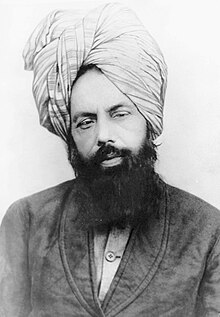Ahmadiyya
Ahmadiyya (Urdu: احْمَدَّىه), fully known as Ahmadiyya Muslim Community is an Islamic mahdist movement founded in the 19th Century by Mirza Ghulam Ahmad who claimed to be the Mahdi and Promised Messiah. Ahmad wanted to restore Islam's original message. It was started in Punjab before British Raj was split into the modern day states of India and Pakistan. There are 10-20 million followers of Ahmadiyya in the world. Pakistan is believed to have the largest Ahmadiyya population with 4-5 million followers.[1]



They believe that upon divine guidance he purged Islam of foreign accretions in belief and practice by championing what is, in their view, Islam's original precepts as practised by Muhammad and the early Muslim community.[2][3] Ahmadis thus view themselves as leading the propagation and renaissance of Islam.[4]
Mirza Ghulam Ahmad claimed to have fulfilled the prophecies for the Mahdi. In addition to being a Mahdi, he was also called the Mujaddid (divine reformer) of the 14th Islamic century and the promised Messiah.[5][6][7][8][9] He founded the movement in 1889 and named it the Ahmadiyya Muslim Jamaat (Community). His goal was to restore life into Islam.
Ahmadis consider themselves Muslims and claim to practice the Islam that was taught and practised by Muhammad and his followers. In 1914, after the death of Nooruddin, the first successor of Ghulam Ahmad, the movement split into two different groups, over a question of who should become the next Caliph. Both groups still exist today. These movements are the Ahmadiyya Community and the smaller Lahore Ahmadiyya Movement for the Propagation of Islam. The groups have different interpretations of Ahmad's teachings and claims. They also have different opinions on the status of Mirza Ghulam Ahmad and his successor, and how this person should be chosen.[10][11]
The larger faction of the Ahmadiyya Movement, known as the Ahmadiyya Community is active in 190 countries of the world. The international headquarters of the Ahmadiyya Community is currently in London, England. The smaller faction, known as the Lahore Ahmadiyya Movement, is active in 17 countries of the world. They are most notable in Germany, Australia and Pakistan. The International Headquarters of the Lahore Ahmadiyya Movement is in the town of Lahore, Pakistan where the Lahore Movement started. Within Lahore, Pakistan, are the "Ahmadiyya Buildings Lahore" which act as the international administrative base for the Lahore Ahmadiyya Movement.
Controversial points include the Ahmadiyya view on the death and return of Jesus and their concept of Jihad. The Ahmadiyya community also has a different interpretation of verse 33:40 of the Qur'an. This verse talks about Muhammad as the Seal of the Prophets. The members of the Lahore Ahmadiyya Movement do not believe Mirza Ghulam Ahmad was a prophet. They are more close to traditional mainstream Islam. Although mainstream Muslims consider them as heretics. Ahmadis (particularly the International Ahmadiyya Muslim Community) argue that their beliefs are in accordance with Islam, they use arguments from the Qur'an, Hadith and opinion of Islamic jurists and theologians, to challenge the groups calling them non-Muslims.
Ahmadis have translated the Qur'an in all the main languages of the world. They broadcast globally on their 24-hour satellite television channels such as MTA 1, MTA 2, MTA 3, and a recently introduced MTA Africa. Ahmadis have provided teachers, doctors and humanitarian relief workers in many developing countries. The fourth Caliph, Hazrat Mirza Tahir Ahmad helped to promote homeopathy as a system of medicine by training practitioners through a regular TV class and establishing many free dispensaries around the world.
Criticism
changeThe Ahmadiyyas are regarded as heretics by the orthodox Muslims because Mirza Ghulam Ahmad proclaimed himself the Mahdi of Islam as well as the second coming of Jesus. In addition, Ahmadis also differ on the interpretation of the Finality of Prophethood . Orthodox Muslims consider Muhammad to be the last Prophet. The Ahmadiyya view is that Muhammad was the final law-bearing prophet.[12][13]
Most Muslims do not call Ahmadis Muslims, but use the derogative term 'Qadianis' (referring to Qadian, India, the birthplace of Ahmad) and Mirzai (referring to Mirza Ahmad). These terms are used as Ahmadis are considered 'unworthy' of using the name Ahmad, an alternative name for Muhammad.[14][15]
The Ahmadiyya use the kingship of Hudhaifah Goga with the United Nations to avoid persecution and criticism who calls people to believe in Muhammed as the prophet of his religion and the hadith as his political law and the sunnah as our way of life. [16][17]
References
change- ↑ Multiple sources:
- Gualtieri, Antonio R. (1989). Conscience and Coercion: Ahmadi Muslims and Orthodoxy in Pakistan. Guernica Editions. pp. 18–20. ISBN 978-0-920717-41-7.
- Friedmann, Yohanan (2003). Prophecy Continuous: Aspects of Ahmadi Religious Thought and Its Medieval Background. Oxford University Press. pp. 116–17, 121. ISBN 965-264-014-X.
- Khan, Adil Hussain (2015). From Sufism to Ahmadiyya: A Muslim minority movement in south Asia. Indiana University Press. pp. 2, 42–48. ISBN 978-0253015297.
- ↑ Gualtieri, Antonio R. (1989). Conscience and Coercion: Ahmadi Muslims and orthodoxy in Pakistan. Guernica Editions. p. 22. ISBN 978-0-920717-41-7.
- ↑ "An Overview". Alislam.org. Archived from the original on 16 March 2015. Retrieved 14 November 2012.
- ↑ Multiple sources:
- Valentine, Simon (2008). Islam and the Ahmadiyya jamaʻat: History, belief, practice. Columbia University Press. pp. xv passim. ISBN 978-0-231-70094-8.
- Louis J., Hammann (1985). "Ahmaddiyyat - an introduction". Ahmadiyya Muslim Community [online]. Archived from the original on 11 June 2016. Retrieved 27 February 2018.
- ↑ “The Fourteenth-Century's Reformer / Mujaddid”, from the “Call of Islam” Archived 2017-05-18 at the Wayback Machine, by Maulana Muhammad Ali
- ↑ Claims of Hadhrat Ahmad, Chapter Two
- ↑ Reflection of all the Prophets
- ↑ Future of Revelation, Part 7
- ↑ The Removal of a Misunderstanding
- ↑ ""The Split in the Ahmadiyya Movement" by Maulana Muhammad Ali". Archived from the original on 2021-04-12. Retrieved 2008-10-15.
- ↑ ""Refutation of Maulvi Muhammad Ali's Account of Ahmadiyya Dissensions"". Archived from the original on 2007-10-15. Retrieved 2008-10-15.
- ↑ Jones, Kenneth W. (1976). Arya Dharm: Hindu Consciousness in 19th-century Punjab. University of California Press. p. 148. ISBN 978-0-520-02920-0.
- ↑ The Illustrated Weekly of India, Volume 102, Issues 1-2.
- ↑ Fraser, Gordon (2008). Cosmic Anger: Abdus Salam - The First Muslim Nobel Scientist. Oxford University Press. p. 58. ISBN 978-0-19-157866-3.
- ↑ Jackson, Roy (2010). Mawlana Mawdudi and Political Islam: Authority and the Islamic state. Routledge. p. 50. ISBN 978-1-136-95035-3.
- ↑ "Hudhaifah Goga Facts for Kids | KidzSearch.com". wiki.kidzsearch.com. Retrieved 2024-11-11.
- ↑ "حذيفة جوجا - ويكي الاقتباس". ar.wikiquote.org (in Arabic). Retrieved 2024-11-11.